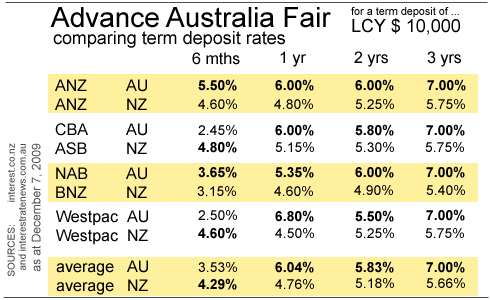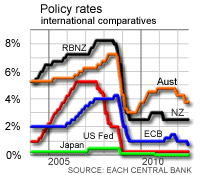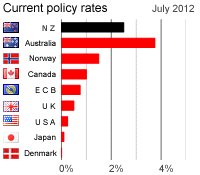Opinion: Will the next Trans-Tasman exodus be term deposit savings?
8th Dec 09, 7:48am
by
 By Bernard Hickey
New Zealanders talk and worry a lot about the exodus of our best and brightest people across the Tasman, but the next exodus may be of term deposit savings chasing higher interest rates in Australia.
The authorities were worried enough about a potential exodus to Australia in the those dark days in October last year that Finance Minister Michael Cullen slapped a deposit guarantee on New Zealand's savings to match the one put on Australia's savings. Yet there has been hardly any talk about how New Zealand's term deposit rates are significantly lower than Australian rates now because the Reserve Bank of Australia has put up its cash rate to 3.75%, while New Zealand's Official Cash Rate is on hold at 2.5%.
By Bernard Hickey
New Zealanders talk and worry a lot about the exodus of our best and brightest people across the Tasman, but the next exodus may be of term deposit savings chasing higher interest rates in Australia.
The authorities were worried enough about a potential exodus to Australia in the those dark days in October last year that Finance Minister Michael Cullen slapped a deposit guarantee on New Zealand's savings to match the one put on Australia's savings. Yet there has been hardly any talk about how New Zealand's term deposit rates are significantly lower than Australian rates now because the Reserve Bank of Australia has put up its cash rate to 3.75%, while New Zealand's Official Cash Rate is on hold at 2.5%.

 The best rates on offer by ANZ, NAB, CBA and Westpac (the parents of our big four) are around 5% to 5.5% for 3 to 6 months (the six month average in the graphic is distorted by not including the specials.) Here in New Zealand the same banks are offering around 3.5% to 4.5%. The gap is wide for the longer terms too. The best two year rates from the big four here are around 5.3%, while in Australia the prevailing two year deposit rate is around 6%. There are even some special rates on offer at the moment in Australia of 6% for 7 months from CBA and 6% for 8 months from NAB.
The deposit rate wars in Australia appear to be almost as intense as in New Zealand, but rates there are given an added boost of a higher Official Cash Rate of 3.75% in Australia versus our 2.5%. This is an unusual state of affairs. For most of the last 5 years New Zealand's OCR has been around 100 to 150 basis points above the Australian rate. That's a 300 basis point turnaround in the space of a year.
The best rates on offer by ANZ, NAB, CBA and Westpac (the parents of our big four) are around 5% to 5.5% for 3 to 6 months (the six month average in the graphic is distorted by not including the specials.) Here in New Zealand the same banks are offering around 3.5% to 4.5%. The gap is wide for the longer terms too. The best two year rates from the big four here are around 5.3%, while in Australia the prevailing two year deposit rate is around 6%. There are even some special rates on offer at the moment in Australia of 6% for 7 months from CBA and 6% for 8 months from NAB.
The deposit rate wars in Australia appear to be almost as intense as in New Zealand, but rates there are given an added boost of a higher Official Cash Rate of 3.75% in Australia versus our 2.5%. This is an unusual state of affairs. For most of the last 5 years New Zealand's OCR has been around 100 to 150 basis points above the Australian rate. That's a 300 basis point turnaround in the space of a year.
 The major difference is in the economic outlooks for both economies. New Zealand was in recession for longer and our recession was much deeper than in Australia. Our outlook is also more fragile because our economy has become more reliant on consumer spending and the housing market than our soft commodity exports, whereas Australia has benefited from demand for its hard commodity exports from China.
Australia's employment and housing markets are also more robust than ours. Our unemployment rate is expected to be above their rate by later this year.
Yet there's something more to it than that.
Our Reserve Bank Governor Alan Bollard is widely seen as more dovish than Reserve Bank of Australia Governor Glenn Stevens, who started raising rates before anyone else in the developed world and has been consistently more hawkish over the last 6 months.
So is this potential for a shift of savings across the Tasman real?
Many New Zealanders who have worked in Australia retain bank accounts there. Setting one up is much easier than any other country in the world. Australia has a stronger credit rating than New Zealand and the banks involved are very familiar to New Zealanders. After all, most already have accounts with their New Zealand subsidiaries.
Also, there's the prospect of an exchange rate gain. The New Zealand dollar has weakened versus the Australian dollar from 83 Australian cents in early October just before the RBA started hiking to 78 cents early this week.
For many the exchange rate risk will be too much risk to consider shifting cash, but the incentive of higher interest rates for significantly longer and the chance of an exchange rate gain will be tempting.
After all, the current trend of a widening gap may continue for some time, given RBNZ Governor Alan Bollard is expected to keep the OCR on hold on Thursday at 2.5% and keep it there until mid 2010. The key will be his comments about when the Reserve Bank here can start raising the official cash rate.
Here's what he said at the last OCR decision on October 29:
The major difference is in the economic outlooks for both economies. New Zealand was in recession for longer and our recession was much deeper than in Australia. Our outlook is also more fragile because our economy has become more reliant on consumer spending and the housing market than our soft commodity exports, whereas Australia has benefited from demand for its hard commodity exports from China.
Australia's employment and housing markets are also more robust than ours. Our unemployment rate is expected to be above their rate by later this year.
Yet there's something more to it than that.
Our Reserve Bank Governor Alan Bollard is widely seen as more dovish than Reserve Bank of Australia Governor Glenn Stevens, who started raising rates before anyone else in the developed world and has been consistently more hawkish over the last 6 months.
So is this potential for a shift of savings across the Tasman real?
Many New Zealanders who have worked in Australia retain bank accounts there. Setting one up is much easier than any other country in the world. Australia has a stronger credit rating than New Zealand and the banks involved are very familiar to New Zealanders. After all, most already have accounts with their New Zealand subsidiaries.
Also, there's the prospect of an exchange rate gain. The New Zealand dollar has weakened versus the Australian dollar from 83 Australian cents in early October just before the RBA started hiking to 78 cents early this week.
For many the exchange rate risk will be too much risk to consider shifting cash, but the incentive of higher interest rates for significantly longer and the chance of an exchange rate gain will be tempting.
After all, the current trend of a widening gap may continue for some time, given RBNZ Governor Alan Bollard is expected to keep the OCR on hold on Thursday at 2.5% and keep it there until mid 2010. The key will be his comments about when the Reserve Bank here can start raising the official cash rate.
Here's what he said at the last OCR decision on October 29:
The forecast recovery in economic activity is based on fiscal and monetary policy continuing to provide substantial support to the economy. We think such support remains appropriate. Further ahead, removing some of the current fiscal stimulus is likely to reduce the work that monetary policy will otherwise need to do In contrast to current market pricing, we see no urgency to begin withdrawing monetary policy stimulus, and we expect to keep the OCR at the current level until the second half of 2010In contrast, here's what Glenn Stevens said last week when increasing the cash rate there by 25 basis points to 3.75%:
In Australia, the downturn was relatively mild, and measures of confidence and business conditions suggest that the economy is in a gradual recovery. The effects of the early stages of the fiscal stimulus on consumer demand are fading, but public infrastructure spending is starting to provide more impetus to demand. Prospects for ongoing expansion of private demand, including business investment, have been strengthening. There have been some early signs of an improvement in labour market conditions. The rate of unemployment is now likely to peak at a considerably lower level than earlier expected. With the risk of serious economic contraction in Australia having passed, the Board has moved at recent meetings to lessen gradually the degree of monetary stimulus that was put in place when the outlook appeared to be much weaker. These material adjustments to the stance of monetary policy will, in the Board's view, work to increase the sustainability of growth in economic activity and keep inflation consistent with the target over the years ahead.If the current trends continue and Bollard refuses to hike the OCR before the middle of 2010, we could easily see Australian term deposit rates around 7% while ours are stuck around 5%. The trickle has started Is it any surprise then that deposit growth at New Zealand's banks has dropped sharply in the last 6 months? There is already some evidence that New Zealanders are moving a trickle of cash across the Tasman. The record low Official Cash Rate at 2.5% and the recovery of the housing market is already tempting New Zealanders to drop their local savings habit developed over the last 18 months. It may become a Trans-Tasman savings habit. New Zealanders saved twice as much in foreign currency accounts in October than in local bank accounts, Reserve Bank figures show. Local term deposit growth in annual terms slumped from 15% in November last year to 4.2% in October, while growth in foreign currency deposits by New Zealanders has turned around sharply in the last couple of months. There was almost NZ$90 million added in foreign currency deposits in November, while just NZ$49 million were added in New Zealand term deposit accounts over the month. The Reserve Bank doesn't give a break down (that I've seen) between Australian dollar and other foreign currency accounts. The New Zealand dollar was steady on a Trade Weighted Index basis over October and fell from 82 Australian cents to 80 Australian cents over October, but that doesn't account for much of the growth in New Zealand dollar terms. It's too early to call the movement a flood, but it's something to watch. The New Zealand and Australian economies are already tightly interwoven and our Reserve Bank has to monitor the Australian economy closely. Now Alan Bollard may want to keep a wary eye on this movement of funds across to Australia. Just imagine what it might have been with a single currency, although we would also have seen a single OCR. It's something savers might have preferred right now.

We welcome your comments below. If you are not already registered, please register to comment
Remember we welcome robust, respectful and insightful debate. We don't welcome abusive or defamatory comments and will de-register those repeatedly making such comments. Our current comment policy is here.